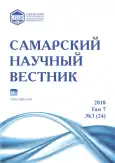Bioindication experience in forests in Tatarstan nowadays
- Authors: Glushko S.G.1, Prokhorenko N.B.2
-
Affiliations:
- Kazan State Agrarian University
- Kazan (Volga Region) Federal University
- Issue: Vol 7, No 3 (2018)
- Pages: 31-35
- Section: 03.02.00 – General Biology
- URL: https://journals.rcsi.science/2309-4370/article/view/21683
- DOI: https://doi.org/10.17816/snv201873106
- ID: 21683
Cite item
Full Text
Abstract
Anthropogenic impact led to the destruction of forests and the destruction of a significant part of them in different regions. The process of destruction over a large area causes the new natural conditions forming. Thus, it is important to find the new methods to assess forests and forest conditions. The use of data regarding dominant, edifying, differential plant species allows assessing forest growing conditions at certain stages of community development. The results of such studies can be used for the purposes of short-term forest planning. The new research materials on the life strategy of forest plants and forest communities in general are important to do a long-term forecast of the dynamics of forest-growing conditions. Complex characteristics of plant behavior or their life strategy reflects the process of adaptation of vegetation to the emerging forest-growing conditions. The authors analyze the possibility of determining the natural conditions by the features of the life strategy of individual forest-forming species (on the example of forests of the Republic of Tatarstan). The type of the vital strategy of tree species was revealed by the indicators of the course or energy of growth, as well as life expectancy. Critically important question concern researching the main forest forming breeds in Tatarstan, which adapt to the emerging conditions, and show signs of pioneering behavior or operational strategy.
Full Text
##article.viewOnOriginalSite##About the authors
Sergei Gennadievich Glushko
Kazan State Agrarian University
Email: glushkosg@mail.ru
candidate of agricultural sciences, associate professor of Forest Assessment and Forestry Economics Department
Russian Federation, KazanNina Borisovna Prokhorenko
Kazan (Volga Region) Federal University
Author for correspondence.
Email: nbprokhorenko@mail.ru
candidate of biological sciences, associate professor of Botany and Plant Physiology Department
Russian Federation, KazanReferences
- Прохоренко Н.Б., Глушко С.Г. Перспективы сохранения хвойно-широколиственных, подтаёжных лесов в Среднем Поволжье // Лес, лесной сектор и экология: материалы всерос. науч.-практ. конф. Казань: Изд-во Казанского ГАУ, 2012. С. 60-63.
- Сукачёв В.Н. Программа и методика биогеоценологических исследований / под ред. В.Н. Сукачева, Н.В. Дылиса. М.: Наука, 1966. 334 с.
- Раменский Л.Г. Введение в комплексное почвенно-геоботаническое исследование земель. М.: Сельхозгиз, 1938. 620 с.
- Работнов Т.А. Фитоценология. 3-е изд., перераб. и доп. М.: Изд-во МГУ, 1992. 352 с.
- Колесников Б.П. Кедровые леса Дальнего Востока. Тр. ДВФ СО АН СССР. Сер. ботан., 1956. Т. 2 (4). 262 с.
- Мелехов И.С. Лесная типология. М.: Изд-во МЛТИ, 1976. 73 с.
- Цыганов Д.Н. Фитоиндикация экологических режимов в подзоне хвойно-широколиственных лесов. М.: Наука, 1983. 196 с.
- Комарова Т.А., Прохоренко Н.Б., Глушко С.Г., Терехина Н.В. Послепожарные сукцессии в лесах Сихотэ-Алиня с участием Pinus koraiensis Siebold et Zucc. Методологические положения и методические подходы в их изучении. СПб.: Своё издательство, 2017. 402 с.
- Глушко С.Г. Лесоводственные свойства древесных пород как фактор лесообразовательного процесса // Мониторинг лесных и сельскохозяйственных земель Дальнего Востока. Владивосток: РАН, ДВ отделение Докучаевского общества почвоведов, 1997. С. 34-45.
- Глушко С.Г. Оценка качественного состояния лесных биогеоценозов в связи с их динамикой // Вестник Казанского государственного аграрного университета. 2016. № 1 (39). С. 16-21.
- Шайхразиев Ш.Ш., Глушко С.Г. Исследование лиственничников Республики Татарстан // Вестник Казанского государственного аграрного университета. 2017. № 4 (46). С. 50-53.
- Глушко С.Г. Биоиндикация природной среды в условиях Республики Татарстан // Вестник НЦ БЖД. 2016. № 3 (29). С. 108-111.
- Ивашкевич Б.А. Дальневосточные леса и их промышленная будущность. Хабаровск: ДВ ОГИЗ, 1933. 286 с.
- Василевич В.И. Очерки теоретической фитоценологии. Л.: Наука, 1983. 247 с.
- Сукачёв В.Н. Растительные сообщества (Введение в фитосоциологию). 4-е изд. Л.-М.: Книга, 1928. 232 с.
- Grime J.P. Plant strategies and vegetation processes // Chichester: Whiley and Sons, 1979. 222 p.
- Комарова Т.А. К вопросу о закономерностях вторичных сукцессий в лесах Южного Сихотэ-Алиня // Динамические процессы в лесах Дальнего Востока. Владивосток: ДВНЦ АН СССР, 1984. С. 21-36.
- Глушко С.Г., Прохоренко Н.Б. Лесоводственные свойства лесообразующих пород // Вестник Казанского ГАУ. 2014. № 3 (33). С. 120-122.
- Порфирьев В.С. Тёмнохвойно-широколиственные леса северо-востока Татарии // Учёные записки Казанского государственного педагогического института. Факультет естествознания. Казань: Татгосиздат, 1950. Вып. IХ. С. 47-119.
- Глушко С.Г. Значение рубок для воспроизводства хвойно-широколиственных лесов Среднего Поволжья // Вестник Казанского государственного аграрного университета. 2014. № 1 (31). С. 108-111.
Supplementary files






